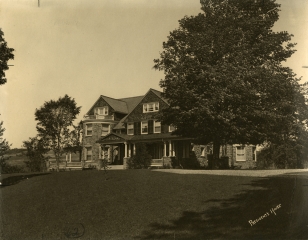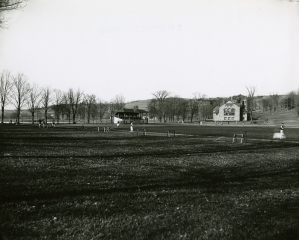acknowledge he had much to learn about educational matters and willing to accept the judgment of the Dean and others.
Dr. Merrill had a clear picture of the University’s finances and sought to improve them. Despite the income from the Dodge Fund there were annual deficits ranging from $22,000 in 1899 to $42,000 in 1908. Of the three divisions of the University, the College accounted for the largest percentage of loss which reached $21,000 in 1908. This increase is explained in part by growth in College enrollment from 151 in 1899 to 287 in 1908 accompanied by more tuitions remitted and additional expenditures for faculty salaries and for maintenance of buildings and grounds. The tuition of $60.00 was much lower than that in most colleges in the east and none was charged in the Seminary; that for the Academy was $45.00. As he had done for the past several years, James C. Colgate made up the deficits, contributing over $300,000 from 1899 to 1908. Meanwhile, the endowment, excluding the $1,000,000 Dodge Fund, grew from nearly $556,000 to $695,513 in 1908.
The University’s munificent patron, James B. Colgate, died at the age of eighty-five in 1904 not long after he had made his last large gift of $100,000 for endowment. In attempting to arrive at a summary of Mr. Colgate’s chief benefactions, admittedly incomplete, Dr. Merrill estimated that they totalled over $1,700,000. Gratefully acknowledging them, he pointed out to the Trustees, none-the-less, that the University would need many friends and many large donations to keep its standing at a time when most of the nation’s colleges were expanding rapidly. On James C. Colgate’s declining to become his father’s successor as Trustee President, the Rev. William M. Lawrence, Class of 1870, was chosen. Formerly pastor of a large Baptist Church in Chicago, where he had a prominent part in founding the University of Chicago, he was an active alumnus and in 1905 had become pastor of the North Orange, New Jersey, Baptist Church.
Dr. Merrill demonstrated a Hair for what later generations would call public relations. He felt that the advantages and needs of the University should be advertised as widely as possible. He traveled extensively to speak before secondary schools, churches and religious groups. Alumni relations he regarded as especially significant and he not only met with alumni clubs but encouraged the forming of new ones. He printed his annual “President’s Report”
and mailed it to








